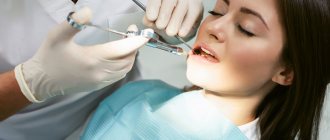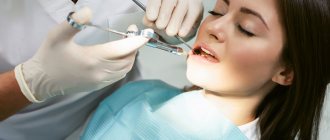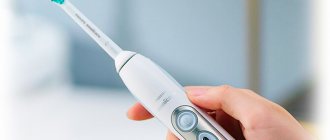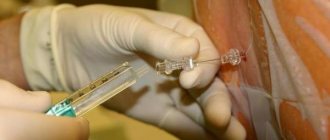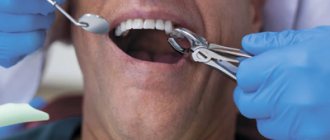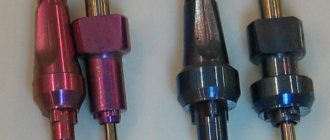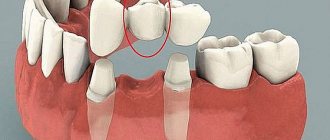1006
The fact that modern methods of dental treatment are carried out almost painlessly is an undoubted achievement in dentistry and the use of effective drugs as an anesthetic.
Many patients, especially older people, are sincerely surprised by the options for freezing the working area, the bizarre shapes of syringes and disposable ampoules.
This article will discuss one of the innovative methods of performing pain relief procedures - carpule anesthesia.
General overview
The name of the technique is due to the design of the syringe, the contents of which sharply reduce the sensitivity threshold of the nerve tissues of the tooth.
The capsule in which the drug is placed is called carpula. Despite the specific packaging of the drug, the manipulation technology itself is standard.
A carpule injection is a reusable syringe. This device is made of a medical metal alloy, and consists of a frame, a piston part and a needle. In this case, the piston cannot be completely removed from the housing, on the side of which there is a gap to accommodate the capsule.
It is a special ampoule containing an anesthetic composition. The capsule is hermetically sealed, has a rubber plug at one end, and a metal valve at the other.
The device works on the following principle - after the cartridge with the necessary product is placed in the gap of the syringe, a needle is screwed into it and an injection is made.
In this case, the plug should be on the side opposite to the needle. When you press the piston, the medicine is injected into the organ cavity and reaches the target.
Equipment
Essentially, a carpule syringe is a metal dental anesthesia syringe that can be used many times and is sterilized in the same way as other dental instruments. A carpule with an anesthetic is inserted into the carpule syringe - a special glass cartridge, factory-made.
Currently, the Trilogy Medical and Dental Center uses carpule syringes for injection anesthesia - they are much more convenient and more sophisticated than conventional disposable syringes.
Advantages
According to practicing dentists, this type of anesthesia has the following advantages over analog painkillers:
- adherence to the dosage as accurately as possible. One carpool unit holds 1.7 ml contents;
- 100% sterility - each injection is performed with a disposable needle, and the contents of the capsule are pumped in strict accordance with antiseptic requirements.
Compliance with sterility standards is especially important for those patients whose immune system is weakened by serious diseases, such as diabetes; - good tolerance - the needle that comes with the device is so thin that inserting it into soft tissues causes virtually no pain. In addition, it simplifies the administration of the drug where the mucosa is close to the periosteal zone;
- comfortable working conditions for the dentist - the syringe is conveniently located in the doctor’s hand and, unlike standard syringes, is easily directed in different directions due to its design features.
The needle is so flexible and durable that it can be bent without fear of it breaking and injuring the patient; - impossibility of administering the wrong drug - the packaging contains a marking with the name and dosage of the composition located inside the capsule.
How effective is Ribbond tape for splinting teeth and the technique of using the material.
Come here if you are interested in detailed instructions for using Metapaste.
At this address https://www.vash-dentist.ru/lechenie/zubyi/vnutripulparnaya-anesteziya.html we will talk about the features of intrapulpal anesthesia.
Types of syringes
For carpule anesthesia, initially only reusable metal injectors were used. Surely many patients have seen these terrible syringes with three rings to support the dentist’s fingers: one at the end of the rod and two at the end of the body. Each injector is designed to provide carpule anesthesia for one patient. After the procedure, the syringe is sent for disinfection, where it undergoes a number of mandatory steps: disassembly, cleaning, sterilization, etc.
Today, reusable metal injectors have been replaced by disposable plastic ones. They are produced in sealed bags, which are opened in front of the patient immediately before carpule anesthesia. The design of the plastic injector is exactly the same, but it is smaller in size and lighter in weight.
The main feature and advantage of disposable carpule syringes is their safety for medical staff. When working with a metal injector, the following often happens: the dentist removes the cap from the needle, administers anesthesia, then, when putting the cap on, misses and pricks.
Curious! A dentist who accidentally pricks his finger on a needle that he has just used for local anesthesia can instantly become infected with various infectious diseases: from hepatitis to HIV.
For plastic injectors, special needles are produced with an additional cap that protects the doctor from accidental microtrauma. This cap is easily pulled out after anesthesia and allows you to remove and then dispose of the needle without the risk of pricking yourself and becoming infected.
Flaws
As for the negative aspects of carpule anesthesia, practically none have been identified.
A number of patients note the high cost of the drug, which makes it limited to the category of citizens with low material income.
However, this is a controversial drawback, since the complexity of manufacturing the product and high efficiency are associated with additional manufacturing costs. A quality product cannot be cheap.
Another disadvantage is the inability to modify the composition. A vasoconstrictor cannot be added to it, but in some clinical cases this is necessary.
Disadvantages of carpule anesthesia
Despite the minor disadvantages described below, carpule anesthesia in dentistry is currently considered the safest and most modern option for injecting an anesthetic.
- Higher price of equipment.
Carpule syringes are more expensive per unit than disposable syringes. This is due to the fact that syringes with carpules for anesthesia in dentistry are quite complex in design, plus really high-quality ones will cost more than simpler options.
- It is impossible to change the concentration of anesthetic inside the cartridge - the cartridge is completely sealed and it is not possible to add anything inside.
Injector contents
The use of the drug requires the dentist to know the composition of the anesthetic. This information is contained on the packaging; there is a detailed breakdown of the percentage of all its components.
Injector includes:
- An anesthetic is a substance that reduces the pain sensitivity threshold in the injection area to a minimum. These compounds are classified under the category of amides and their derivatives. These are mainly Lidocaine, Prilocaine, Articaine;
- vasoconstrictor – activates vasoconstrictive processes, which prolongs the relief of nerve endings and increases the effect of the drug.
In addition, the substance prevents premature leaching of the drug from the working area.It has a serious limitation for use - the drug is prescribed with extreme caution to people with pathologies of the cardiovascular system, diabetes mellitus at any stage of the disease, and elderly patients. Vasoconstrictors include adrenaline, mesaton;
- antioxidants are mainly sodium sulfites or bisulfites.
Their main function is to protect the vasoconstrictor from destructive processes that occur under the negative influence of an oxygen environment. They can provoke individual intolerance, including acute allergic reactions, since they contain sulfur fragments. Contraindicated for diseases affecting the lungs and bronchi; - preservatives – ensure the safety of the composition until it is opened;
- EDTA – metal binder;
- parabens are fragments that ensure absolute sterility of the capsule contents. This is especially important when transporting to regions with hot climates.
Thanks to this balanced composition, the anesthetic is reliably protected from the penetration of pathogenic microorganisms.
The main requirement related to the specific composition of the anesthetic is to make sure before using the medicine that the patient is not allergic to its derivatives.
Neglect of this rule is fraught with anaphylactic shock, which can cause irreparable harm to human health.
The video provides a description of an innovative single-use carpule syringe.
What is sedation in dentistry?
As an alternative to general anesthesia, sedation in combination with local anesthesia is used. Sedation is the administration of sedatives that put the patient into a light superficial sleep, helping to relax and calm down during dental treatment. Sedation is used in the treatment of both adults and children.
There are three ways to administer sedation drugs:
- inhalation - during the entire treatment the patient inhales a soothing gas (a mixture of oxygen and nitrous oxide) through a mask;
- intravenous - injection of a drug suitable for a particular patient;
- oral - the medicine is usually dissolved in a glass of water or juice.
Sedation is not anesthesia; it is used in combination with local anesthesia.
There are few contraindications to sedation:
- age up to three years;
- individual intolerance to drugs;
- respiratory diseases;
- neuromuscular diseases, epilepsy.
The use of nitrous oxide is contraindicated if:
- intracranial hypertension, i.e. increased pressure in the cranial cavity;
- hyperexcitability syndrome.
Storage rules and periods
Any medicine needs proper storage. Capsules must be kept in a dark place. The optimal storage temperature is 23-25 degrees.
Failure to comply with basic conditions will shorten the shelf life of the composition, and improper transportation may compromise the structural integrity of the package.
Such drugs should not be used under any circumstances. Injectors should be stored in places inaccessible to children and pets.
Signs of loss of drug properties
You can understand that the medicinal effect of the drug has been neutralized and it has lost its main characteristics by a number of signs:
- the integrity of the packaging is compromised - most often this is due to careless transportation;
- An uncharacteristic sediment has appeared in the liquid or the shade of the composition has changed - this happens when the temperature regime is violated, causing overheating. The vasoconstrictor disintegrates and the agent changes its structural content;
- the appearance of gas bubbles larger than 0.2 cm. This is a consequence of freezing;
- the appearance of rust fragments on the outside of the ampoule.
How to find out that an infection has occurred during dental treatment and how to correct the situation.
In this article we will discuss methods of tooth restoration after endodontic treatment.
Here https://www.vash-dentist.ru/lechenie/zubyi/desensitayzeryi-v-stomatologii.html read about the importance of desensitizers in dentistry.
Popular means
The most popular option for carpule anesthesia is the products of French manufacturers, which are effective and affordable:
- Ultracaine is the most popular concentration for dental pain relief. The effect occurs after a couple of minutes and lasts for at least an hour;
- Ubistezin - the duration of pain relief does not exceed half an hour, this time is sufficient in most clinical cases. Indications for use: children, pregnant women;
- Scandonest – has a high concentration of adrenaline. Side effect is a long-term vasoconstrictor result. Prevents bleeding;
- Septanest - has a mild effect. The sensitivity threshold remains extremely low for 15-20 minutes. Indicated for people prone to allergies, with severe pathologies and serious chronic diseases, when the use of stronger drugs is not recommended.
Reasons for the lack of pain relief
In some cases, the effect of the product may be minimal or absent altogether, that is, tissue sensitivity remains almost at the same level.
There are reasons for this. If we exclude damage to the packaging and a violation of the properties of the composition, the lack of pain relief is explained by the following factors:
- fear of the upcoming procedure - fear blocks other reflexes, and anesthesia does not occur;
- production of adrenaline - it is intensely produced in moments of panic and enters the nerve cells, neutralizing the effect of the drug.
To exclude such manifestations, experts recommend that patients prone to panic fear of the dentist take a sedative half an hour before the procedure.
Chronic alcohol dependence, as well as the body’s addiction to the drug, can have an inhibitory effect.
Conditions that local anesthetics must adhere to
In general, local anesthetics should:
- Do not cause allergies
- Have minimal toxicity to the body
- Have few side effects
- Easy to dissolve and excrete
In addition to this, anesthetic agents are required to:
- The effect is strong enough to completely anesthetize the tooth and surrounding tissues.
- Rapid numbness - no more than 5 minutes after the injection
- The numbness should last at least an hour - so that it is enough for the entire procedure, including the very last manipulations
- Anesthesia should take place no more than 2-3 hours later.
- Long-term stability of the drug itself – at least 2–3 years
Reviews
Carpule anesthesia is used almost everywhere in domestic clinics.
Its main purpose is to eliminate the fear of treatment and make it as comfortable as possible.
If you are interested in this article, you can leave your comment in the appropriate section. Surely your opinion will be useful to someone.
If you find an error, please select a piece of text and press Ctrl+Enter.
Tags
Did you like the article? stay tuned
Previous article
Septopak in dentistry - a material for reliable protection
Next article
Lotus braces are a guarantee of quick and reliable correction of any bite defects
